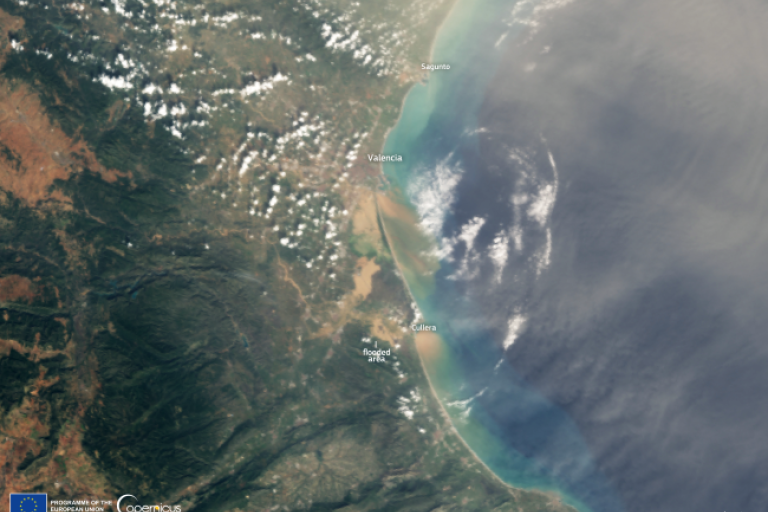Record-breaking rainfall and flash floods have hit Spain, causing many dozens of casualties and massive disruption and economic losses in the latest of a series of flooding disasters that have hit communities around the world. It underlines why the top priority of the WMO community is to save lives as climate change super-charges extreme weather. �
The Valencia region was worst affected, with many places receiving more than 300 l/m². On 29/30 October, a weather station in Chiva received 491 l/m² in just eight hours – the equivalent of a year’s worth of rainfall, according to AEMET – Agencia Estatal de Meteorología.
A massive rescue and relief operation was mounted as the reported death toll topped more than 200. Images showed people swept away in cars and raging torrents of deadly water. Tens of thousands of people in Valencia were without power and transport was disrupted. The Spanish government declared three days of national mourning.
AEMET, which is the official source of authoritative warnings in Spain, issued numerous warnings under the Common Alerting Protocol. This is a standardized message format designed for all media, all hazards, and all communication channels. That is, a universal format for emergency alerts, ensuring critical information reaches everyone.
A top-level red alert was in place for 1 November for the province of Huelva, on the south-west tip of Spain, which has also been hit by torrential rain. Cartaya, for instance, received 117 l/m² in less than 3 hours – 70l of them in just one hour. The airport of Jerez in southwestern Spain received a record 114.8 mm of rain in 24 hours on 30 October, it said. An second-tier alert was in place for eastern Spain, including the Valencia area.
WMO works with its Members, the National Meteorological and Hydrological Services, to ensure that timely, accurate forecasts reach people in time and lead to early action. Our core mission is to save lives and livelihoods and this is what drives the international Early Warnings For All initiative.
Other parts of Europe have also been badly hit by floods this year. In mid-September 2024 a very large region in Central Europe experienced very heavy rainfall, breaking local and national rainfall records.
Role of Climate Change
According to the Intergovernmental Panel on Climate Change, extreme weather events causing highly impactful floods and droughts have become more likely and more severe due to anthropogenic climate change. And this has been borne out by repeated events.
“As a result of rising temperatures, the hydrological cycle has accelerated. It has also become more erratic and unpredictable, and we are facing growing problems of either too much or too little water. A warmer atmosphere holds more moisture which is conducive to heavy rainfall,” said WMO Secretary-General Celeste Saulo.
The phenomenon which hit Spain – known as Isolated Depression at High Levels, or DANA in Spanish – often occurs during the autumn season because the remaining warm surface heat from summer meets a sudden cold invasion aloft from the polar regions. This leads to what meteorologists used to call ”’a cut-off system” with low-pressure values that persist over a few days and rotating over the concerned region. It also impacted southern France.
“The presence of warm air near the surface being fueled by excessive moisture from the still-warm Mediterranean Sea and the instability generated by the conflict with cold air in the upper atmosphere leads to large convective clouds with heavy downpours and sudden flash floods,” says Omar Baddour, chief of Climate Monitoring at WMO.
“Climate change is expected to make these systems more intense because of warmer sea waters and increasing moisture in the atmosphere,” he said.
For each 1°C of warming, saturated air contains 7 percent more water vapour on average. Every additional fraction of warming therefore increases the atmospheric moisture content which in turn increases the risk of extreme precipitation events.
A similar “cut-off” system in September 2023 (Storm Daniel) caused massive devastation in Greece and then moved on to Libya where it triggered the collapse of dams, causing massive loss of life.
World Weather Attribution
Climate scientists at World Weather Attribution – which includes experts from National Meteorological and Hydrological Services issued a paper on 31 October: Ten years of rapidly disentangling drivers of extreme weather disasters. It traced how the science of attribution has progress sufficiently to analyse the role of climate change in individual events.
In a rapid analysis on Spain, the group estimated that the rainfall was about 12% heavier and twice as likely compared to the 1.3°C cooler preindustrial climate. The conclusions were well aligned with previous attribution studies on heavy rainfall in Europe, such as Storm Daniel and Storm Boris.
The World Weather Attribution scientists have issued other studies which found that climate change increased the intensity of rainfall and impact of flooding disasters in the Sahel and West Africa, East Africa, Asia (Nepal, India, Pakistan and Afghanistan) and southern Brazil this year.
However, the studies found that many other factors including urbanization, land and water management and poverty also played a role in individual disasters.
WMO’s State of the Global Climate 2024 Update, which will be published at the UN Climate Change Negotiations COP29 in Baku, Azerbaijan, will present details of some of the worst extreme events this year and their impacts.
